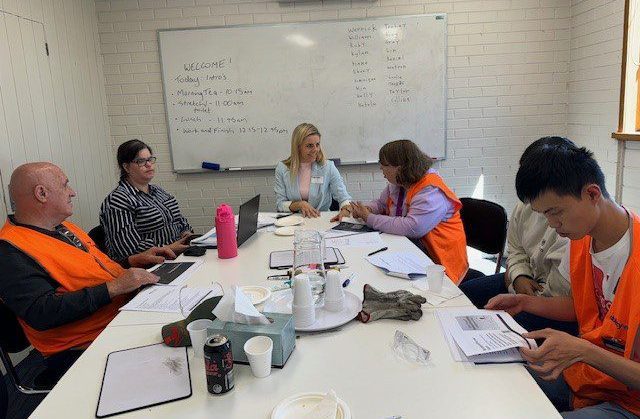Thanks to a unique collaboration with Ability Works, White Box Enterprises' Financial Wellbeing Program is becoming more accessible for everyone.
White Box Enterprises began working with Ability Works towards the end of 2023. But what started as participation in the Financial Wellbeing Program evolved into something bigger: a co-designed accessibility toolkit that’s set to leave a lasting impact on the program.
Empowering financial wellbeing through co-design
Launched in February 2023 and funded by the Ecstra Foundation, White Box’s Financial Wellbeing Program aims to integrate financial education into the vital wrap-around support jobs-focused social enterprises provide. It equips employees with the confidence and skills to manage their money more effectively.
At the heart of the program’s success is the co-design process.
Kelly Taylor, National Programs Manager at White Box Enterprises, says the developmental approach is critical.
“We don’t make assumptions about what is needed,” Kelly explains.
“We allow the responsiveness of the group to flow without predetermined outcomes. Everyone’s voice matters, and we all share the role of co-facilitators, which creates an environment where participants feel safe, confident, and motivated to contribute.”
This inclusive method has yielded tailored programs that are more reflective of the real-life experiences of employees, which in turn enables the training to be delivered more effectively.
By focusing on self-reflection learning and individual experiences, the training fosters financial knowledge, skills, and confidence based on each person’s lived experience with money, acknowledging that different employees have different experiences (for example debt can be a result of involvement in the criminal justice system) and different learning needs.
Independent evaluation of the program’s first year supports this approach, showing that financial capability can only be strengthened if engagement tools and materials resonate with people the program is trying to reach. (Read the full Year 1 evaluation here)
The process also aligns the training with each social enterprise’s existing support models, making it easier for them to integrate the program without disrupting their operations.
Partnering with Ability Works
Ability Works, a social enterprise providing employment opportunities for people with disabilities, joined the program in late 2023.
Natalie Collins, Inclusive Design Lead at Ability Works, says understanding aspects of managing money, understanding tax, superannuation and the Ability Works pay slip were issues members of the support team were fielding on a regular basis and they thought training would be beneficial.
“Participants enjoyed being able to participate in the co-design process and seeing the outcome of their input,” she said.
Ability Works CEO Sue Boyce says the program left many of their employees feeling more empowered.
“It fostered a sense of independence and adulthood,” she says.
“The budgeting skills they learned not only helped them take greater control of their finances but also allowed them to start planning for future goals, like buying a home.
“It's been incredibly rewarding to see our team take charge of their financial destiny and build confidence in their own abilities.”
Dominique Loulie, Inclusive Design Projects Coordinator at Ability Works who participated in the program and the co-design process, agrees the program was useful.
“Although I may have limited financial literacy skills, having access to content has given me the same opportunity as others to better manage my money and become financially independent. I am stepping out of my comfort zone and trying new things I wouldn’t normally do,” he says.

Dominique Loulie, Inclusive Design Projects Coordinator at Ability Works
Creating a toolkit
Ability Works didn’t just participate in the co-design process—they also co-created an accessibility toolkit to ensure that future iterations of the program are accessible to everyone, regardless of their abilities.
Natalie said they knew that for this program to be successful, they would need to consider developing materials and delivering training in a range of ways and thought they could share their learnings.

“The aim is to create awareness around different approaches to producing information and training that is engaging and will work for anyone participating. It recognises that people learn in different ways and that accessible content should be the starting point,” she said.
“Learning should be fun and meet the needs of the people participating. I hope the guide we developed helps White Box Enterprises to work with more organisations in an inclusive way.”
Dominique, who is also a participant in the Payment by Outcomes (PBO) trial, was instrumental in developing the toolkit.
He used his lived experience, including his background in inclusive design and challenges with hearing loss, to inform its creation.
“Growing up with hearing loss, I struggled to navigate a hearing world and lacked access to accessibility toolkits,” he says.
“Communicating with friends of varying literacy levels was challenging. With the current toolkit, I can now continue where I left off.”
The toolkit addresses everything from colour contrast and clear language to screen reader compatibility and keyboard navigation, ensuring that digital content is accessible to people with varying abilities.
Dominique says he is proud of the font choice.
“What I find exciting is that Aptos is replacing Calibri as the new default Office font for Microsoft. It’s clean, modern, and easy to read. I am proud to pick this font because it helps reduce visual stress, supports individuals with dyslexia, and improves comprehension by making text more user-friendly,” he said.
Kelly says this collaboration shows what can be achieved when organisations embrace inclusivity.
She notes that the dual focus on co-designing a tailored program package and creating the accessibility toolkit was mutually enriching.
“It has enabled a very close working relationship,” she says.
“We were lucky. We weren’t restricted by ticking boxes or tight deadlines, which allowed our co-design principles to flourish. This creative freedom resulted in something truly relevant and engaging.”
The importance of accessibility
As White Box continues rolling out the Financial Wellbeing Program, the focus remains on more than just financial education. It’s about creating inclusive spaces where all employees can thrive.
For Taylor, the key takeaway is simple: “There’s diversity within diversity. The way we deliver this program must be person-centred and tailored to the individual. That’s a key principle of how we roll out this program.
“We’re constantly learning and adapting. Working with Ability Works taught me a lot about how to design content that’s truly accessible—from the choice of font to the way we facilitate learning in face-to-face settings. I’m excited to share this with future participants in the program.”
The accessibility toolkit will now be part of the Financial Wellbeing Program moving forward.
Best practice advice
Dominique says that by making accessibility a priority from the start, you can avoid the need for adjustments later. Here he shares some best practice advice for ensuring digital content is accessible:
- Keyboard Navigation- Lets users move around with a keyboard.
- Screen Reader Compatibility- Makes sure screen readers can read the content.
- Alt Text for Images- Adds descriptions to images for screen readers.
- Text Alternatives for Multimedia- Provides captions and transcripts for videos and audio.
- Colour Contrast- Ensures text is easy to read for everyone.
- Clear Language- Uses simple words for easy understanding.
- Responsive Design- Works well on all devices and screen sizes.
- Focus Indicators- Shows what’s selected when using a keyboard.
- Accessible Forms- Makes it easy to fill out and submit forms.
- Your Audience- Make content fun and engaging.
- Test with Real Users- Checks for real-world accessibility issues with feedback.

